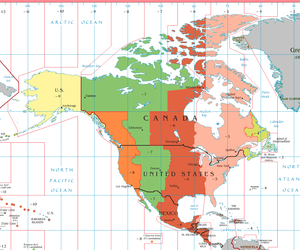Newfoundland Time Zone
| Newfoundland Time Zone | |
|---|---|
| Time zone | |
 | |
| UTC offset | |
| NST | UTC−03:30 |
| NDT | UTC−02:30 |
| Current time | |
| 16:20, 28 October 2024 NST [refresh] 17:20, 28 October 2024 NDT [refresh] | |
| Observance of DST | |
| DST is observed throughout this time zone. | |
The Newfoundland Time Zone (NT) is a geographic region that keeps time by subtracting 3.5 hours from Coordinated Universal Time (UTC) during standard time, resulting in UTC−03:30; or subtracting 2.5 hours during daylight saving time.[1] The clock time in this zone is based on the mean solar time of the meridian 52 degrees and 30 arcminutes west of the Greenwich Observatory. It is observed solely in the Canadian province of Newfoundland and Labrador. The Newfoundland Time Zone is the only active time zone with a half-hour offset from UTC in the Americas.
Scope
[edit]Officially, per Newfoundland and Labrador provincial law, the entire province observes Newfoundland Time.[2] In practice, however, Newfoundland Time is observed only on the island of Newfoundland, its smaller offshore islands, and the southeastern Labrador communities south of Black Tickle. The rest of Labrador, from Cartwright north and west, observes Atlantic Time along with the rest of Atlantic Canada. Southeastern Labrador prefers Newfoundland Time in part to synchronize with the schedule of radio broadcasts from Newfoundland.
This time zone exists because of the location of the island and the fact that it was a separate dominion when time zones were established. Newfoundland lies squarely in the eastern half of the Atlantic Time Zone, with St. John's being exactly three-and-a-half hours from Greenwich. Since the Dominion of Newfoundland was separate from Canada, it had the right to adopt its own time zone when time zones were first created. While the entire province lies west of the standard meridian for a half-hour time zone, 52.5 degrees west longitude, this is also the near exact meridian of St. John's, the province's capital and largest city. In 1935, the Newfoundland Commission of Government adopted a Standard Time Act which set standard time across the Dominion of Newfoundland at 3.5 hours behind Greenwich Mean Time (GMT).[3]
In 1963, the Newfoundland government attempted to move the province to Atlantic Time in tandem with the rest of Atlantic Canada, but withdrew in the face of stiff public opposition.[4][5]
Daylight saving time is observed throughout the province. In 1988, the provincial government experimented with double daylight saving time, moving clocks ahead two hours during daylight saving time instead of just one. However, this forced children to go to school in the dark in October.[6] In 2006, the province enacted an extension to daylight saving time,[7] starting in 2007, following the lead of the United States and other Canadian provinces.
This unusual time zone puts the island of Newfoundland an hour and a half ahead of Central Canada, a half hour ahead of the rest of Atlantic Canada, and half an hour behind Saint-Pierre and Miquelon. Because of this, it will hit milestones of time before (almost) any other part of the continent, a quirk that draws attention to Newfoundland. For instance, the Newfoundland releases of Harry Potter and the Half-Blood Prince and Halo 2 were publicized across Canada. Also, it is very common for the lone independently owned-and-operated TV station in the province, CJON-DT (known on-air as "NTV"), to use a "World Television Premiere" bumper at the start of some programming that airs before most other North American stations air them.
Likewise, in the case of Canada-wide broadcasts timed to air at the same local hour in the rest of the country through the use of a different feed for each time zone (most commonly the CBC's radio and TV networks), Newfoundland uses Atlantic-time broadcasts. References to programs airing at "6:00, 6:30 in Newfoundland" are commonly heard across Canada. However, whenever the province's two full-fledged stations, CJON and CBNT-DT (both based in St. John's), originate local programming, they usually refer to it as "coming up at 6:00, 5:30 in most of Labrador."
Major metropolitan areas
[edit]See also
[edit]- Newfoundland's Daylight Saving Act of 1917
Sources
[edit]- Official times across Canada
- World time zone map Archived 2015-12-24 at the Wayback Machine
- History of U.S. time zones and UTC conversion Archived 2007-09-22 at the Wayback Machine
- Canada time zone map
- Time zones for major world cities
References
[edit]- ^ Standard Time Act 2006.
- ^ "Rsnl1990 Chapter S-23 - Standard Time Act".
- ^ Hawthorn, Ainsley (4 November 2023). "Half an hour later in Newfoundland: The origin of Canada's 30-minute time zone". CBC News. Retrieved 4 November 2023.
- ^ "Newfoundland". Archived from the original on February 11, 2012.
- ^ "Turn Backward, O, Time!" (PDF). The Daily News. 1963-05-27. Archived from the original (PDF) on June 17, 2011.
- ^ Benesh, Peter (1988-06-21). "Daylight Almost Until Midnight: Newfoundland Tries out Double Daylight-Saving Time". Orlando Sentinel. Retrieved 2020-02-02.
- ^ Standard Time Act, Government of Newfoundland and Labrador
